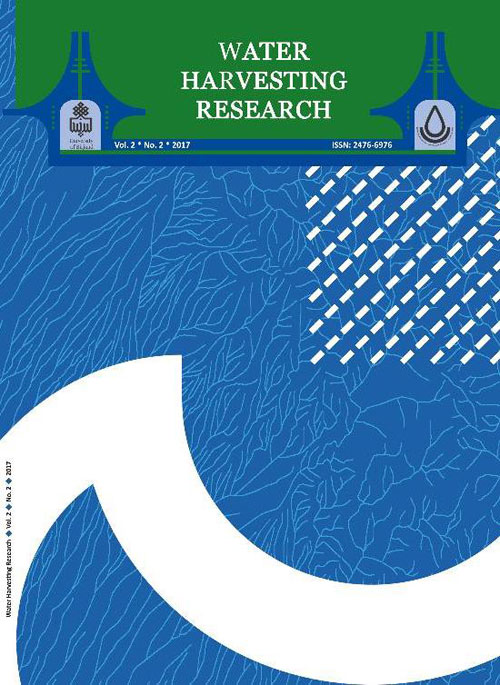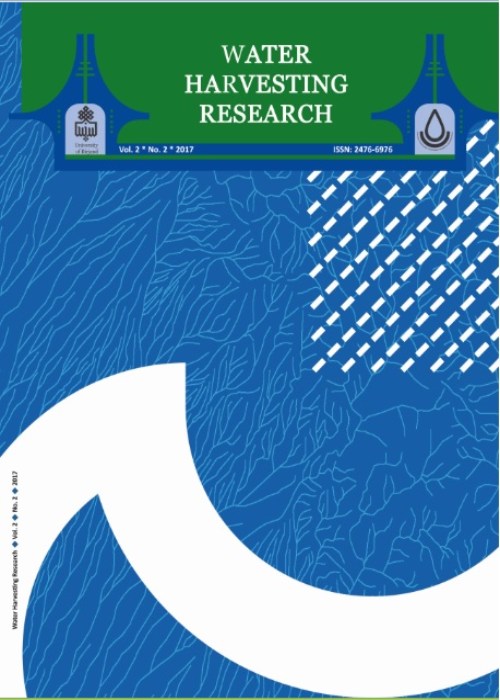فهرست مطالب

Journal of Water Harvesting Research
Volume:2 Issue: 2, Summer and Autumn 2017
- تاریخ انتشار: 1396/05/10
- تعداد عناوین: 6
-
Mapping the flood-prone areas for developing a flood risk management system in the northeast of IranPages 1-12Flood hazard and disaster in Iran is one of the most frequent and damaging types of natural disaster. The Gorganroud watershed in the Golestan province recently has incurred severe damages resulted from flood events. Thus, this work was aimed to assess and map the flood susceptibility areas in the Gorganroud watershed to propose a comprehensive layout for flood monitoring and alarming stations. The Analytic Hierarchy Process (AHP) integrated with Weighted Linear Combination (WLC) approach within the GIS environment was employed to extract flood hazard zones. Results revealed that the cities Maraveh Tape, Bandar Gaz, Gorgan, Galikesh, Kordkooy, Minoodasht, Azadshahr, Kalale, Ramian, Gonbadkavoos, Aghala, Bandar Torkaman, and Gomishan with the ranks of 1 to 10, respectively populated the highest proportion of the "High" hazard class. Additionally, two percentages of the cities Aliabad, Azadshahr, Galikesh, and Gorgan were exposed to the hazard class of "Very High". According to results, about 32% of the villages and 26% of their population in the study area are exposed to the high and very high flood hazard zones. Furthermore, around 50% of the populations within high and very high hazard zones are 65 yr who are vulnerable to natural hazards. Based on the results of the flood hazard zoning, a layout of the monitoring plan for the flood warning system in the Gorganroud basin was proposed. This plan comprised 74 repeater stations and 215 alarming stations and fourteen control and monitoring centers were considered to collect and display data from all stations, as well.Keywords: AHP, flood risk management, flood warning, a monitoring station, hazard zoning, multi-criteria evaluation
-
Pages 13-29This study conducted to assess the impacts of climate changes on hydrological regime of Langat River Basin using the Soil and Water Assessment Tool (SWAT). The Statistical Downscaling Model (SDSM) applied as a practical tool to bridge the spatial difference between GCM grid-box scale and sub-grid box scale in the Langat River Basin as a tropical area. The calibrated and validated SDSM was applied to project the possible scenarios in two future periods (2030s and 2080s) of meteorological variables. The SDSM predicts increasing mean monthly precipitation and maximum temperature during the two future periods. The Sequential Uncertainty Fitting (SUFI-2) algorithm was used for sensitivity analysis and calibration of the SWAT model in simulating of observed average monthly streamflow. The observed data matched reasonably well with the simulated flows with respect to Nash-Sutcliffe coefficient, PBIAS, RSR, and R2 with values of 0.62, 5.7, 0.61, 0.63 during calibration process (1997–2004) and 0.55, 3.5, 0.67, 0.56 during validation process (2005-2011), respectively. The projected results of monthly streamflow revealed that the average annual streamflow may increase about 71% and 108% in future mid-century and significantly for end century period, respectively along with increase in surface runoff.Keywords: SDSM, CGCM3.1, SWAT model, SUFI-2, tropical area, Malaysia
-
Pages 30-38Unfortunately, in Iran and other countries in the Middle East region, water becomes scarcer than ever before, and over the last decades, the demand for domestic water has increased due to population and economic growth. Although rainwater harvesting is considered to be a safe and reliable alternative source for domestic water, the inconvenience or impracticalities related to the cost and space needed for the construction of ground or underground storage tanks makes this practice not widely common in rural areas and rarely implemented in urban cities. This paper introduces a new technique to rainwater harvesting which can be easily used in both rural and urban areas; it collects and stores rainwater directly from rooftop catchments and not necessarily in the special ground or underground ones. This system was examined in one of villa garden of Mazandaran province (Babolrood catchment) to provide the irrigation water for one-hectare citruses garden, this villa garden has one two-story building that the second floor is to settlement and the first floor is a water storage with 100 m3 capacity that each time 26 m3 and during the year 52 m3 water is stored and transfers from storage to pool of gathering water and then it is transferred by Hydration pipes through gravity as drip irrigation to the foot of the trees and consuming water has been estimated for each hectare to irrigate 19 m3, and in a normal water year 3-5 years old trees need 2-3 irrigation that mostly is 50-57 m3 water. Therefore harvesting water is a suitable method to meet water of one-hectare citrus grove by floor insulation levels, and also it needs 4-5 irrigation courses in the drought times. We usually encounter to drought period every ten years, we need to advance the floor insulation levels and if the area of the garden is increased we must increase our floor insulation levels. If widely adopted in Iran Particularly in Mazandaran province, this technique could help in: (1) collecting around 70 % of the current deficit in the domestic water supply) of rainwater (2) saving around 7 % of the amount of electric energy usually needed to pump water from an aquifer well and ground or underground tank, and (3) considerably reducing the rate of surface runoff of rainwater at the hill area where rainwater is not captured at all and ultimately goes to the sea.Keywords: Rooftop catchment, Garden citruses irrigation, Rainwater harvesting system, Villa gardens, Babolrood catchment
-
Pages 39-46Minimum and maximum precipitation and their oscillations in a specific period of time is a common phenomenon all around the world, which depend on the type of climate. With the climatic variety present in Guilan province, precipitation oscillations are so complicated compared to the average. Precipitation data were collected from weather stations of the Guilan Regional Water Authority and the Meteorological Organization, and they were then reconstructed using the Minitab software. Using the statistical analysis, the minimum and maximum precipitation of twelve stations were estimated, and next to the thirty-year recurrence interval was calculated using the HYFA software. Due to the number of data and stations, the five weather stations of Manjil, Lahijan, Rasht, Rudkhan Castle and Anzali were picked out using the clustering method, and the map of precipitation and their area was created using the GIS. Anzali and Rudkhan Castle stations possess the highest precipitation in their statistical period, while Manjil possesses the lowest amount of precipitation in the whole province, and suffers from more water shortage and aridity compared to other stations. Lahijan and Rasht stations can be classified as stations with medium precipitation, i.e. both conditions equally affect the area. The authorities should be more careful and sensitive when making plans for this region. Unbalanced oscillations and highly severe recurrence intervals must be considered in environmental, agricultural and tourism planning, to reduce the potential losses resulting from strong and weak precipitation, and to prevent the failure of various projects due to lack of correct information and plans.Keywords: climate, the return period, Guillen, precipitation
-
Pages 47-53This paper proposes floodwater harvesting as a countermeasure for ever-increasing water shortages in a semi-arid region of Iran. Characteristics of local Mediterranean climate are highlighted as a major constraint for direct use of seasonal runoff produced by small catchments. Rainfall and runoff measurements were carried out during four consecutive years in order to evaluate hydrological data obtained by regional analysis. The result indicates that regional analysis might have caused overestimation for runoff volume and unreliable monthly distribution. Registered data, shows that occasional rainfalls (In this case only once a year) are the only opportunities for floodwater harvesting. It is therefore understood that the water storage is very important for regulating the individual runoff in order to support crop water requirements along the year. A design chart has been developed to be used for optimization of storage capacity with respect to cultivated area and the corresponding risk of water shortage.Keywords: Floodwater harvesting, Arid region, Regional analysis, Reservoir optimization, Runoff estimation
-
Pages 54-70The world's population is continuously growing, so the water demand is increased and the water crisis tends to intensify the use of groundwater. With regard to the reduction of groundwater resources, the use of surface water is a priority. Base flow is the minimum flow rate that flows in the river. Base flow is the maximum discharge which is extracted from the river regardless of the environmental flow. In this research, to estimate the main flow and its index at a daily time step for 8 representative gauging stations located at the Gorganroud river basin during a period of 34 years (1981 to 2014) the Hysopp methods (local minimum, fixed intervals and Sliding-interval), B-Flow method, one-parameter digital filter method, Chapman digital filter method, EWMA method and Eckhardt method used to estimate base flow index from the measured streamflow, and their results compared. Using two parameters of α and BFI max, the base flow was separated by Eckhart's method and the base flow index was calculated. Finally, it can be observed that one-parameter digital filter method (with MAE, RMSE and r values of 0.28, 0.22, and 0.976, respectively), and the Chapman digital filter method (with the MAE, RMSE and r values of 0.29, 0.33 and 0.979, respectively) give the best results. In both methods, the base flow has the least standard deviation (SD≤0.66), which was selected as the best flow separation method in the study area.Keywords: Baseflow, Gorganroud, Recession curve, Water Extraction


